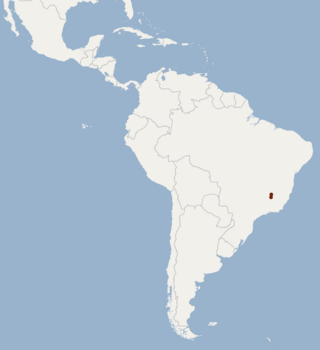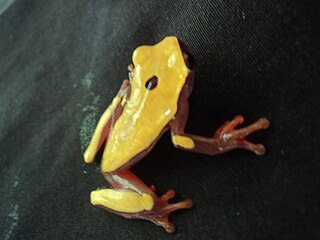
Bokermann's nectar bat is a bat species from South America. It is endemic to Brazil. It feeds on nectar, and is listed as an endangered species.

Amazophrynella bokermanni is a species of toad in the family Bufonidae. It is endemic to Brazil and only known from the region of its type locality, the Amazonas state. Its natural habitats are old-growth forests where it occurs in leaf-litter. The eggs are laid on aerial roots over temporary pools where the tadpoles then develop.

Bokermann's casque-headed frog is a species of frog in the family Hylidae. It is endemic to Brazil, known only from Juréia-Itatins Ecological Station, another location 10 km away and Rio Verde. Its natural habitats are subtropical or tropical moist lowland forests.

Dendropsophus acreanus is a species of frog in the family Hylidae. It is found in western Brazil, northeastern Bolivia, and southeastern Peru.

Dendropsophus bifurcus, commonly known as the Upper Amazon treefrog, is a species of frog in the family Hylidae. It is found in the upper Amazon Basin of Bolivia, Brazil, Colombia, Ecuador, and Peru. Dendropsophus bifurcus is an abundant and widespread species that inhabits bushes in open forest and clearings. It breeds in permanent and temporary shallow ponds. Eggs are laid out of the water on leaves whereas the tadpoles develop in the water.
Dendropsophus gaucheri is a species of frogs in the family Hylidae.

Dendropsophus molitor is a species of frog in the family Hylidae, known commonly as the green dotted treefrog. It is endemic to Colombia. Its natural habitats are subtropical or tropical high-altitude shrubland, subtropical or tropical high-altitude grassland, shrub-dominated wetlands, swamps, freshwater marshes, intermittent freshwater marshes, pastureland, plantations, rural gardens, urban areas, irrigated land, and seasonally flooded agricultural land.

Dendropsophus leucophyllatus is a species of frog in the family Hylidae. It is found in the Amazon Basin . This widespread and locally common species is found near water in a wide variety of tropical habitats. There are no known significant threats to this species.

Dendropsophus parviceps is a species of frog in the family Hylidae. It is found in the Amazon Basin of Bolivia, Brazil, Colombia, Ecuador, Peru, and Venezuela. Dendropsophus parviceps is a locally common species with no known threats. These frogs are found on the leaves and branches in primary and secondary tropical rainforest, but also in open spaces close to forests. It is found in moist habitats. It breeds in temporary bodies of water. Eggs are laid in water where the tadpoles develop.

Dendropsophus rhodopeplus is a species of frog in the family Hylidae. It is found in the upper Amazon Basin in Bolivia, Brazil, Colombia, Ecuador, and Peru.

Dendropsophus rubicundulus is a species of frog in the family Hylidae. It is found in Bolivia and Brazil. Earlier records from Paraguay are probably based on misidentified Dendropsophus jimi and Dendropsophus elianeae, but it is still likely to be also found in that country.

Dendropsophus sarayacuensis is a species of frog in the family Hylidae.
Dendropsophus schubarti is a species of frog in the family Hylidae. It is found in Bolivia, Brazil and Peru. Its natural habitats are subtropical or tropical moist lowland forests and swamps.
Dendropsophus studerae is a species of frogs in the family Hylidae.

Dendropsophus triangulum is a species of frog in the family Hylidae. It is found in the upper Amazon Basin in Bolivia, western Brazil, Colombia, Ecuador, and Peru.
Crossodactylodes bokermanni is a species of frog in the family Leptodactylidae. It is endemic to Espírito Santo state of eastern Brazil. While its range is small, it is locally abundant. It is an arboreal species living in forests near 560 m (1,840 ft) altitude. It is associated with epiphytic bromeliads where its tadpoles develop. It is threatened by habitat loss.
Crossodactylus trachystomus is a species of frog in the family Hylodidae. It is endemic to the Espinhaço Mountains in Minas Gerais, Brazil.
Physalaemus bokermanni is a species of frog in the family Leptodactylidae. It is endemic to Brazil. Its natural habitats are subtropical or tropical moist lowland forests and intermittent freshwater marshes. It is threatened by habitat loss.
Werner Carlos Augusto Bokermann was a Brazilian zoologist who specialized in herpetology and ornithology. He collected and described numerous new species.












